What can i feed my baby ball python
What To Feed Baby Ball Pythons
Do you have a baby ball python, but you’re worried about feeding it the wrong thing?
Are you concerned about the safety and health of your small python’s diet?
It’s important to make sure you always feed our ball python’s the right thing, but owners need to make sure the baby ball python gets what it needs.
This is why you need to know what to feed a baby ball python.
Baby ball pythons still eat only protein-based animals just like adult ball pythons do. The main thing to watch for is the prey is of the correct size. Pinky mice or fuzzy rats (babies of these forms) and large crickets are the typical diets for baby ball pythons.
Check out the rest of the post for more details on what and how to feed a baby ball python.
Table of Contents
What To Feed Baby Ball Python
This section deals with a little more detail on what to feed a baby ball python.
There are a few options and other elements to consider.
Size
The size of the food is the most important concern with baby ball pythons.
They can’t handle large food as well as adults can.
It’s much more likely for a baby to choke and regurgitate than it is an adult.
The size rule applies to baby and adult ball pythons alike, but for babies, this is a hard and fast rule with little wiggle room.
The prey should be no larger than the snake’s body at mid-length.
With baby ball pythons, this limits the types of food available to give them.
The next sections go over the most common choices for food.
Pinky Mice
The most common choice for baby ball python food is pinky mice.
Despite the unique name, this isn’t a special breed of a mouse at all.
Pinky mice (also written as a pinkie) are baby mice whose fur hasn’t fully grown in.
As a result, these mice have a pink look to them and are very small.
This is where the name pinky mice come from.
Though rats are usually better for ball pythons, at the small-sized baby pythons, it won’t matter which you use.
Another reason pinky mice are more typical is how they’re more readily available.
Most snakes will eat mice throughout their lives, and most snakes will eat pinky mice as babies themselves.
This high demand has resulted in high supply as well.
Pinky mice are the correct size, affordable, and easily available.
Fuzzy Rats
Fuzzies are baby rats or juvenile mice.
Rats are considered the better staple food for the health of ball pythons.
They’re one of the ball python’s natural prey.
But at the baby size, ball pythons aren’t as picky, and fuzzies aren’t as easily available as pinky mice.
If you do pursue fuzzies, make sure the size is correct for the size your ball python currently is.
Large Crickets
For baby ball pythons, large crickets are also an option.
You will need to sprinkle a dietary supplement or gut load the crickets beforehand to make sure they provide the necessary nutrients for the snake.
As the snake ages, it will quickly grow out of the crickets, but as young ones, they work just fine.
How To Feed Ball Python
Feeding ball pythons is surprisingly simple.
In most cases, all you need to do is put the prey in the cage and watch it go to town.
Young ball pythons may struggle more to find the food.
Make sure you place it near the ball python’s head, so it senses the food is nearby.
Live prey is always better and will be easier to feed to the snake.
When live prey moves, it attracts the attention of the python and activates its hunting instincts.
Live prey also has a powerful scent.
For frozen prey, make sure it’s naturally thawed out before feeding.
This will help with the smell (and the safety of the python).
You may wish to brain the prey or tap the snake with the food lightly to get its attention.
Young ball pythons only need to eat once every 5-7days.
This may not seem like enough, but it’s exactly right for them.
As they get larger, you’ll find they eat less often and turn their nose up at the food.
This is normal.
Adult ball pythons only eat every 10-14 days.
The python will bite and wrap itself around the food, then proceed to swallow the prey whole.
Over the next 48 hours, it will work on digesting the food, and you’ll see the lump in its body.
During this time, don’t handle the ball python.
Handling a ball python while it’s digesting may make it vomit up its food.
This is hard on the snake’s body and prevents nutrient absorption.
How Long Can A Baby Ball Python Go Without Eating?
While adult ball pythons may go 3-4 months without eating and up to 6 months (though they shouldn’t), the baby ball python has no reason to go anywhere near this long.
Every 5-7 days, you need to offer the ball python food.
There are only two main reasons a baby ball python won’t eat.
The python is ill.
This is the first thought many owners have when something odd with their pet happens.
Often, it’s not about illness, but the next reason.
However, if you see some companion signs of illness with a lack of appetite, don’t be afraid to get your pet checked out.
Here are common signs of illness:
- Visible injuries or “kinks” in their bodies
- Raspy breathing
- Pus and discharge in the mouth or eyes
- Changes in droppings
- Lethargy (lack of movement in the extreme)
- Mouth breathing
- Lack of appetite
- Cloudy eyes
- Stargazing (stiff body with head stuck up)
The ball python is about to shed.
Ball pythons and most reptiles are the same in this way. If they’re about to shed their skin, they won’t eat.
Younger reptiles shed more often because they’re growing more often.
Baby ball pythons may shed up to once per week or more if they’re hitting a growth spurt.
If your plan to feed them falls one of these days, they just won’t eat.
Look for signs of shedding, which include whitening skin, glassed over eyes, and cranky behavior.
Don’t help along in the shedding process.
Let it happen naturally.
Once it’s over, then offer food to the ball python again. It usually eats quickly after a shed.
What To Do If Your Baby Ball Python Won’t Eat
There are times outside of the reasons above your ball python will be reluctant to eat.
Here are a couple of tricks to use to get them to eat.
Brain the food – Sometimes frozen and thawed prey won’t be small strong enough to activate a snake’s instinct to eat.
This happens on occasion with live prey too.
One almost fool-proof tactic is to make a small cut in the prey’s skull and press on the prey’s body until blood and other materials come out.
This puts more scent in the air and helps the snake recognize the prey as food.
Tease the python – One other tactic includes what’s called “teasing” the snake.
This tactic is especially helpful with baby ball pythons, who sometimes have difficulty finding the food they smell.
With teasing, you take the prey and tap their heads and noses gently.
You may want to move the food around in front of the snake as if it were alive.
When you see the python notice the prey, move your hand away quickly but not so jerky it locks its attention onto your hand.
Let the smell build – Ball pythons hunt in large part by smell, so it’s important to make the prey smell as powerfully as it can.
For frozen and thawed foods, this is tougher.
One trick used by many is to take a small plastic container and poke holes in the top.
Place the thawed food in the container and place the container in the python tank.
Let it sit there for a while.
As the prey warms up, the smell will increase in the small container.
By having small holes in the container, the smell is amplified in the air and attracts the snake’s attention better.
When the ball python begins to inspect the container, you know it’s interested.
It’s at this time you should carefully remove the lid and let the snake go to town.
Conclusion
Now you know about what to feed baby ball pythons.
Pinky mice, fuzzy rats, and large rickets are your go-to foods.
Just make sure, as with all prey for ball pythons, the prey is no larger than the size of the snake’s body at mid-length.
Feed them once every 5-7 days, and your young ball python will develop just fine.
What Do Baby Ball Pythons Eat?
As an Amazon Associate I earn from qualifying purchases.
The most common concern faced by ball python owners is what to feed their pets. When they are having difficulties maintaining a feeding schedule for their snakes, this issue usually comes up.
Because each animal has its own set of nutritional needs in order to stay healthy in captivity, so do all reptiles. While some skinks have a wide range of foods, others, such as ball pythons, are unable to do so.
As a result, before acquiring a pet, you should conduct extensive studies on it. Especially on its housing needs and diet. Ball pythons in the wild consume everything from rats to birds to tiny animals to lizards.
Especially on its housing needs and diet. Ball pythons in the wild consume everything from rats to birds to tiny animals to lizards.
Despite the fact that baby ball pythons eat nothing but animal protein, they ingest it in a similar way as adult ball pythons do. The most essential thing to note is that the prey must be the appropriate size. Pinky mice and fuzzy rats are the typical diet of baby ball pythons, as well as large crickets.
The most crucial aspect when it comes to baby ball pythons is the size of the meal. They can’t eat as much as adults can, and they can’t tolerate huge meals. A newborn is far more likely to choke and regurgitate than an adult.
The size restriction is the same for both baby and adult ball pythons. However, this is a strict rule with no leeway for interpretation. Smaller than the snake’s body at mid-length is the ideal size for prey. This restricts the amount of food available to give to baby ball pythons.
Pinky Mice
Pinky MicePinky mice are the most popular baby ball python diet. Despite their unusual name, this is not a unique breed of mouse. Pinkie mice, sometimes known as pinkies, are young mice with ungrown fur.
Pinky mice have a pink tint to them and are exceptionally tiny as a result of this. The name pinky mice are derived from this. Even though rats are typically preferable for ball pythons, it will not matter which species you pick at tiny baby pythons.
Pinky mice are more common because they’re easier to come by. Because most snakes will eat mice throughout their lives, and most snakes will consume pinky mice as younglings, it’s not unusual for them to be more available. Pinky mice are the greatest, and they’re also readily accessible. The high demand for pinky mice has resulted in an overabundance of them.
Fuzzy Rats
A Fuzzy RatFuzzies are baby rats or juvenile mice. Rats are considered the superior staple food for ball pythons because they are high in protein and low in carbohydrates. One of the ball python’s natural food sources. When it comes to fuzzy infants, though, ball pythons aren’t as picky, and pinky mice aren’t as readily available. If you want to feed fuzzies, be sure they’re appropriate for your current ball python.
One of the ball python’s natural food sources. When it comes to fuzzy infants, though, ball pythons aren’t as picky, and pinky mice aren’t as readily available. If you want to feed fuzzies, be sure they’re appropriate for your current ball python.
Large Crickets
A CricketLarge crickets are likewise a choice for baby ball pythons. To ensure that the crickets deliver all of the required nutrients to the snake, sprinkle them with a nutritional supplement or gut load them ahead of time. The crickets will last for a long time if the snake is an adult. However, as newborns, they are just fine.
What Do Baby Ball Pythons Eat in The Wild?Ball pythons are ambush hunters who conceal themselves during the day by blending in with their surroundings. There are significant variations in the diet and behavior of male and female ball pythons, which have sexual dimorphism. Males are more reliant on trees than female black bears, with females spending more time on the ground.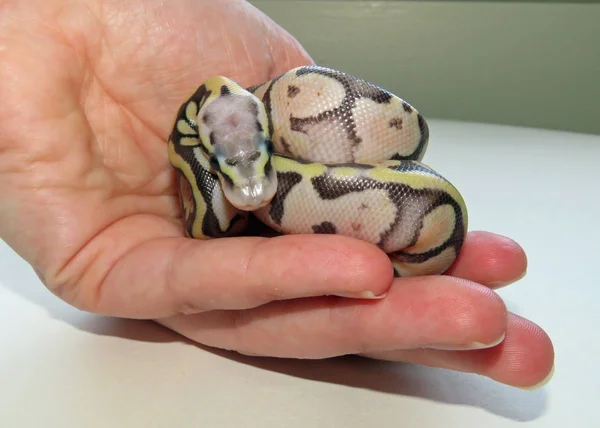 This has an impact on prey availability and consumption.
This has an impact on prey availability and consumption.
The snakes are nocturnal, and because they feed exclusively on birds and mammals, their diet is restricted to these two species. The males, on the other hand, consume more birds than females, who are more earthbound. Smaller ball pythons under 70 cm have been observed to eat mostly birds, whereas those longer than 100 centimeters preyed primarily on mammals.
Because pythons actively seek out rodents as food, they have been able to adapt effectively to human-altered habitats. They may also be helpful in keeping rodent pests under control on farms. The African giant rat, spotted grass mouse, black rat, shaggy rats, and rufous-nosed rats are some of the rodents that may be found in these locations as preferred meals.
How To Feed Baby Ball Pythons? A Ball PythonThe majority of captive-hatched ball pythons are hungry eaters, despite the fact that it may be difficult to get them to feed. You’ll just need to follow these steps:
Health & Habitat CheckUp
Most ball pythons will not eat if they are sick or in need of appropriate habitat, especially snakes, especially ball pythons. The majority of keepers who encounter feeding difficulties will identify one of these two causes as the root of the problem.
The majority of keepers who encounter feeding difficulties will identify one of these two causes as the root of the problem.
You should have taken your snake in for a vet check right after purchasing him to verify that he is fit. And, by reading the basic Ball Python Habitat Guide, you can ensure that you have the enclosure set up correctly.
Grab The FoodFrozen-thawed rodents are the finest things to feed your ball python. The animals will be delivered to you in a frozen state, but you’ll want to let them warm up to room temperature before feeding them to your snake. Freezing-thawed rodents is the best option for feeding your snake because it eliminates the risk of harm. It also ensures that the rodent does not suffer.
The ideal size for an adult is a juvenile mouse or tiny rat, however, newborns will need smaller rodents. You can get frozen rats from most pet stores that sell snakes. Alternatively, you may buy them online directly from a rodent breeder.
It’s critical not to frighten or stress your snake before, during, or after the feeding procedure. Give him food for at least a few hours after handling him. Try to eliminate any unnecessary distractions while he is away from his cage. If you’re not expecting visitors, dim the room lights somewhat. Before attempting to quiet excited kids or pets, exit the area and consider lowering the room lights a touch.
After introducing the habitat, seize the rat’s neck scruff with the forceps, not his tail. Slowly move it in front of your snake and allow him to strike it for a second before moving on. If he doesn’t react when you animate the prey item, you may need to stimulate life into it (or vice versa).
Release The Food ItemYour ball python strikes and constricts the meal item without hesitation, and perhaps you’ll be able to capture a photo of it. Once he does so, let go of the rodent and slowly back away from the habitat.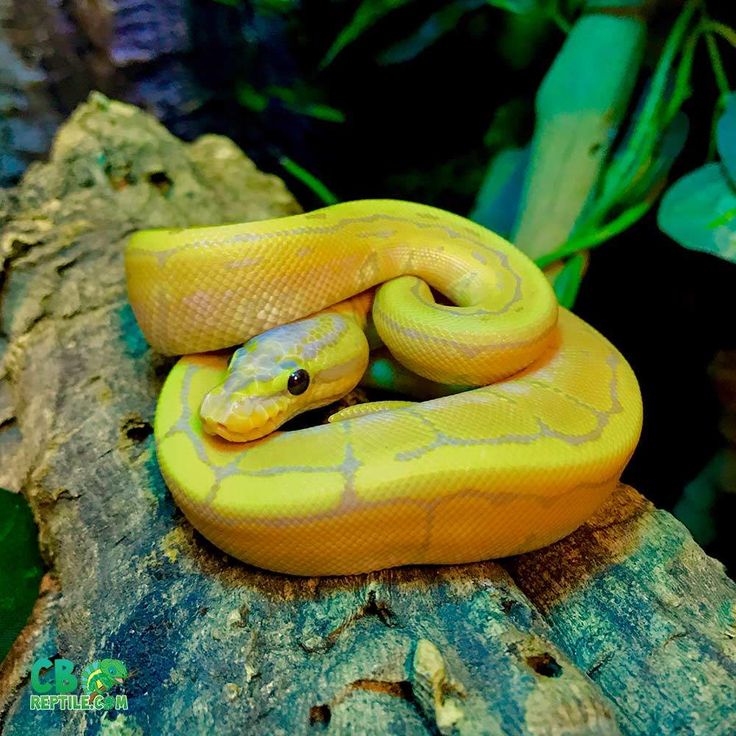 If you want to go, you must do so carefully, as the snake will become alarmed if you open the enclosure too abruptly. Simply leave the chamber open until your snake has finished eating the food item if you want to watch him eat.
If you want to go, you must do so carefully, as the snake will become alarmed if you open the enclosure too abruptly. Simply leave the chamber open until your snake has finished eating the food item if you want to watch him eat.
When administering food to your snake, keep in mind the importance of cleanliness. After all of this, wash your hands with soap and water.
It’s also critical to remember that rats may occasionally shed blood, urine, or feces throughout the feeding process. Clean up any spills as soon as possible, but avoid aggravating your snake in the process. Regurgitation can occur when handling your snake following a meal, so allow at least 24 to 48 hours for your snake to rest quietly after each feeding.
What Are The Natural Predators of Baby Ball Python?The Ball Python does not have many predators in the wild. It is a predator that eats everything from birds to goats to pigs in the wild. The python may capture, kill, and eat an animal several times its own size in the wild. The snake has no natural predators in its native regions in Asia, but it has been introduced to locations like the Florida Everglades, where there are no species that eat pythons.
The snake has no natural predators in its native regions in Asia, but it has been introduced to locations like the Florida Everglades, where there are no species that eat pythons.
Eagles can capture pythons, as can large birds like eagles. The python is a slow-moving species after a substantial meal. Because it hides among tree branches and leaps on its prey, predators have chances of capturing it.
CrocodilesThe python lives in water and is threatened by crocodiles while swimming. A young animal can be taken and eaten by a crocodile of any size, but the older a python gets, the larger it grows. Only a huge crocodile may capture and consume a big python.
Lions, Pumas, and TigersLarge cats, such as lions, pumas, and tigers which may be found in the python’s natural environment, might capture and consume the snakes. Because the python is non-venomous, it’s up to the predator to avoid getting wrapped in it, at which point the snake’s constriction may actually suffocate the predator.
Young pythons can be eaten by cobras. Other snakes, such as anacondas, are also predators of immature animals and devour the eggs when they become available. Because of their size, older pythons are not threatened by other snakes.
HumansHumans are the biggest predator of pythons, frequently killing them for their skin as well as their meat. Pythons that are caught are usually skinned alive and left to die. Humans are the only active predator of the python in areas where it has been introduced, such as the Everglades, however, they seldom consume it.
How Do Baby Ball Pythons Protect Themselves? A Baby Ball PythonBall pythons are one of the most popular pet snakes in the world. They hail from Central and West Africa’s tropical grasslands and savannas, where they prefer to blend in rather than alarm predators. Balling up is their most well-known defensive strategy, hence the name.
When we’re assaulted or missiles are hurled at us, our first impulse is to defend ourselves by ducking down and raising our arms.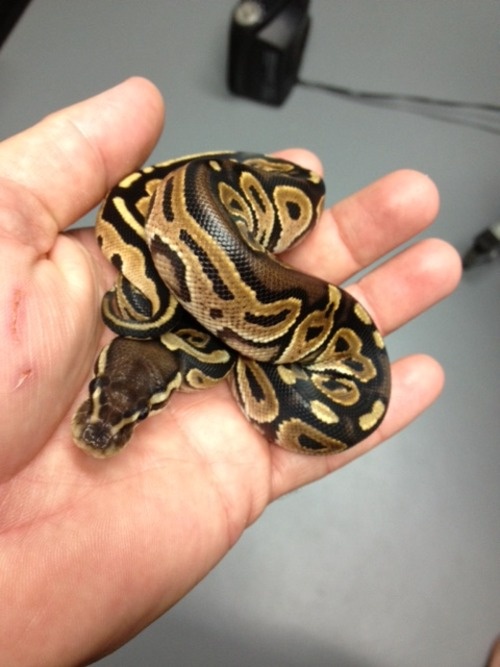 We raise our arms up and conceal our faces because we’re afraid!
We raise our arms up and conceal our faces because we’re afraid!
We don’t want to get injured. Ball pythons are rather similar. When they sense danger or anxiety, they will curl up and hide their heads away. They don’t want to be harmed either, so all they can think about is that you are larger than they are!
If their anxiety or fear gets too high, or they’ve tried rolling up and it hasn’t worked, they may go into a striking posture. This means that their neck is bent in a zig-zag pattern, with a back-and-forth shape, since they are poised to strikeout.
Because of their excellent leverage, ball pythons have better control when holding onto a branch or balancing on the ground. If your ball python attacks you, it does not imply that you are its food. A strike is a brief snap, followed by a retreat.
They are defensive in nature because they bite and refuse to let go. If your snake bites you and refuses to release, that means it confused you for food, gaffa!
Is It Healthy to Eat Baby Ball Pythons?A study conducted a decade ago found that Everglades National Park pythons had dangerously high levels of mercury, a neurotoxin that can harm brain function and the reproductive system. 3.5 parts per million is the maximum amount of mercury found in pythons tested by US Geological Survey research scientist David Krabbenhoft. The EPA recommends that consumers avoid eating anything with a mercury concentration of more than 0.46 percent.
3.5 parts per million is the maximum amount of mercury found in pythons tested by US Geological Survey research scientist David Krabbenhoft. The EPA recommends that consumers avoid eating anything with a mercury concentration of more than 0.46 percent.
A python bite may necessitate a variety of treatments, even if it is nonvenomous. It might not only cause damage but also allow germs to enter your body. Even if the injury appears minor, contact a physician.
Bites from your pet ball snake may be treated by cleaning the wound with warm water and soap. To aid the healing process, you might want to wrap the bite region in bandages to prevent infection.
Even if the wounds appear minor at first, bites that are more serious may require immediate medical attention. A severe bite can happen if you keep your pet ball python clamped on your skin for more than a few seconds.
Amazon and the Amazon logo are trademarks of Amazon. com, Inc, or its affiliates.
com, Inc, or its affiliates.
what is important to know what to feed, recommendations
Published: 08/27/2020 Reading time: 5 min. 9034
Share:
The snake as a pet is a growing phenomenon. These beautiful animals attract with elegance and unpretentiousness. Royal pythons are especially in demand. It is believed that this snake is suitable for beginners: it is not very active, rather unpretentious and non-aggressive. The size of the royal (or ball python) is 1–1.5 m, it has a thick muscular body, an elegant triangular head - this is a very beautiful snake.
Content
- What should be the content of the python
- What and how to feed a snake
- Reptilife for python health
What should be the contents of a python
The snake does not need constant daily care, but in order for the reptile to be healthy and live a long time, you need to create suitable conditions for it:
- spacious terrarium.
 Dimensions depend on the size of the python: it should be comfortable inside;
Dimensions depend on the size of the python: it should be comfortable inside; - volumetric drinking bowl-pool. Snakes do not just drink from water containers, they also swim there, so there should be a lot of water, and the drinker itself should be well fixed;
- temperature regime. In the coldest corner, the temperature should be at least 26 ° C, in the warmest - up to 32-36 ° C. The background temperature comfortable for a python is about 28 °C. The optimum humidity is 80-90%.
What and how to feed a snake
Python is a predator. During the hunt, he strangles and swallows the victim whole. It can digest what it eats for several days or several weeks, depending on the size of the object. At home, the snake should be fed with food that is as close as possible to its natural prey.
- As a rule, owners of snakes buy food mice or rats, frozen or alive, in pet stores. Some pythons do not perceive an already dead mouse, since there is no thermal radiation from it.
 To make the food more attractive, it must be warmed in water to a temperature of 40 degrees;
To make the food more attractive, it must be warmed in water to a temperature of 40 degrees; - The first meal after the first lace shedding is very important. A young python cannot starve for a long time, and it must be fed. So get ready to be flexible in your choice of food items and offer your python mice, rat pups, or even young gerbils. In the most extreme case, force-feeding is used, but only under the supervision of an experienced specialist;
- frozen rodents are much more convenient as food, but require snake habituation. Be sure to check if the carcass is completely defrosted;
- frequency of meals depends on age. The interval between feedings of cubs should be 4-5 days, an adult python - from 1 to 3 weeks. Keep in mind that pet snakes are prone to obesity, so adjust your meals according to your pet's condition. Female pythons tend to be more voracious and larger;
- sometimes the snake refuses to eat. This is normal if the hunger strike does not last too long, although it is royal pythons that can starve for no reason for up to six months.
 The python also does not eat well during the molting period, when the temperature drops, if there are stress factors in its environment. If the pet does not eat for too long, has become inactive and drowsy, has lost weight and lost weight, contact a specialist;
The python also does not eat well during the molting period, when the temperature drops, if there are stress factors in its environment. If the pet does not eat for too long, has become inactive and drowsy, has lost weight and lost weight, contact a specialist; - Live rodents, especially rats and hamsters, can chew on a python. Therefore, if the snake is not interested in prey, it is better to postpone feeding for a day or two and remove the rat from the terrarium.
Reptilife for python health
To maintain the snake's health, provide it with the necessary vitamins and microelements, including during active growth or molting, the Reptilife Powder vitamin and mineral complex will help. The feed supplement was created specifically for reptiles, taking into account their needs, it contains vitamins A, K3, C, D, E, vitamins of group B. It will allow you to cope with beriberi, normalize metabolism, and recover from illness. It is convenient to use the supplement when the python has already switched to eating thawed food.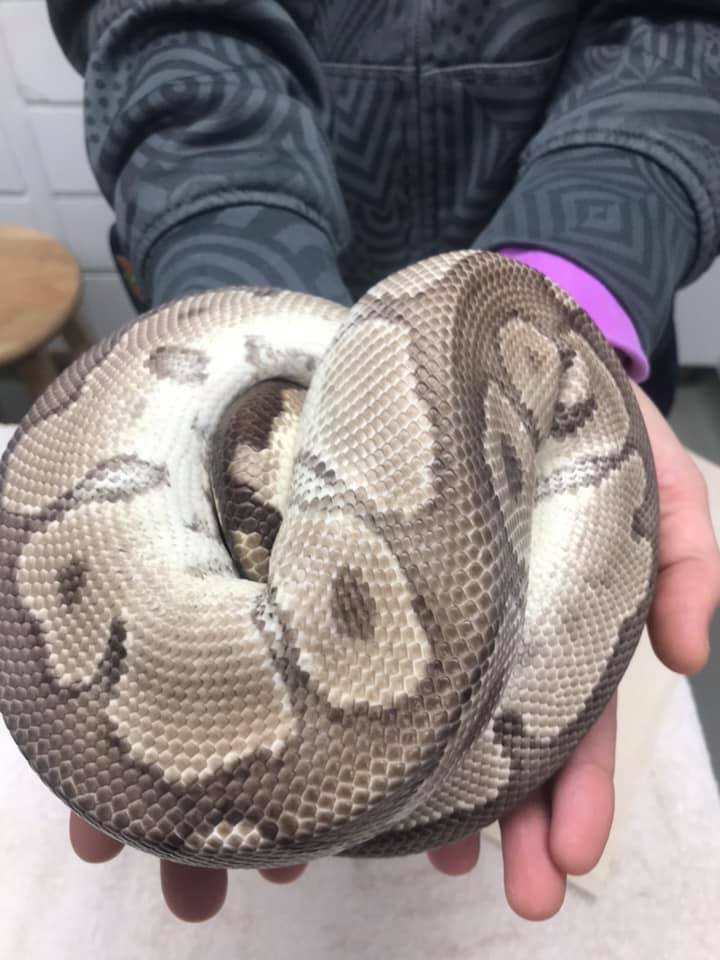 It is enough to slightly moisten the carcass of a rodent and roll in vitamin powder.
It is enough to slightly moisten the carcass of a rodent and roll in vitamin powder.
Author: AVZ
Add comment
Rate article
Share:
Back to tips list
More tips related to
Content of the Yemeni chameleon
Read more
Setting up a terrarium for a tortoise
Read more
How to care for a ball python. Python royal normal (Python regius) Python royal care and maintenance
Royal python, photo, maintenance, feeding of the royal python, breeding of pythons - 5.0 out of 5 based on four votes
Royal python (Python regius), the smallest member of the genus, not exceeding one and a half meters in length, inhabits the countries of Western and Equatorial Africa - from Senegal to Nigeria and Cameroon. The head pattern consists of a large dark triangular spot on top and lateral oculotemporal stripes, between which lies a narrow yellow stripe.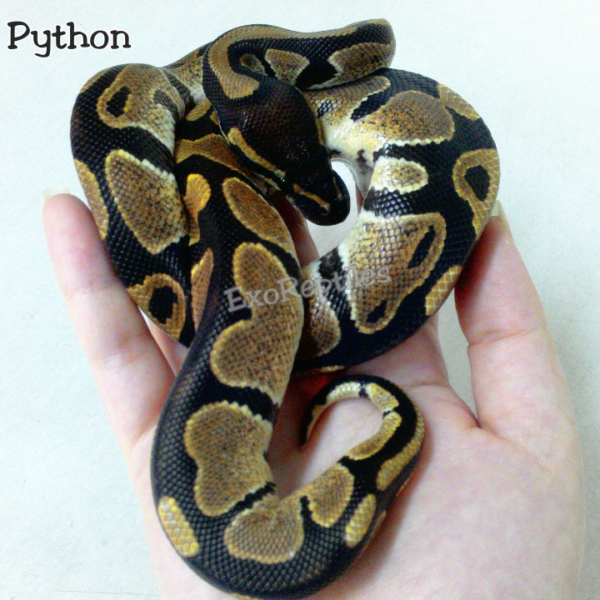 The coloration of the body of the royal python is very characteristic - two dorsal-lateral dark stripes run along the body from the head, connected by dark transverse bridges. Towards the middle of the body, the distance between the bars increases, they themselves expand, and the longitudinal stripes are interrupted in places, and additional spots appear on the light dorsal fields.
The coloration of the body of the royal python is very characteristic - two dorsal-lateral dark stripes run along the body from the head, connected by dark transverse bridges. Towards the middle of the body, the distance between the bars increases, they themselves expand, and the longitudinal stripes are interrupted in places, and additional spots appear on the light dorsal fields.
Irregularly shaped protrusions descend from these stripes, covering light side spots, inside which, in turn, there is a dark spot. The royal python hunts small animals and birds, which it guards, having settled down somewhere on the branches of a tree and hanging down the front part of the body. In case of danger, he rolls up into a tight ball, hiding his head inside it, and at this time one person cannot unfold it. That is why in some countries it is called "ball python" (ball python).
Pythons are kept in horizontal terrariums, as these pythons are predominantly terrestrial. The size of the terrarium depends on the size of the animals.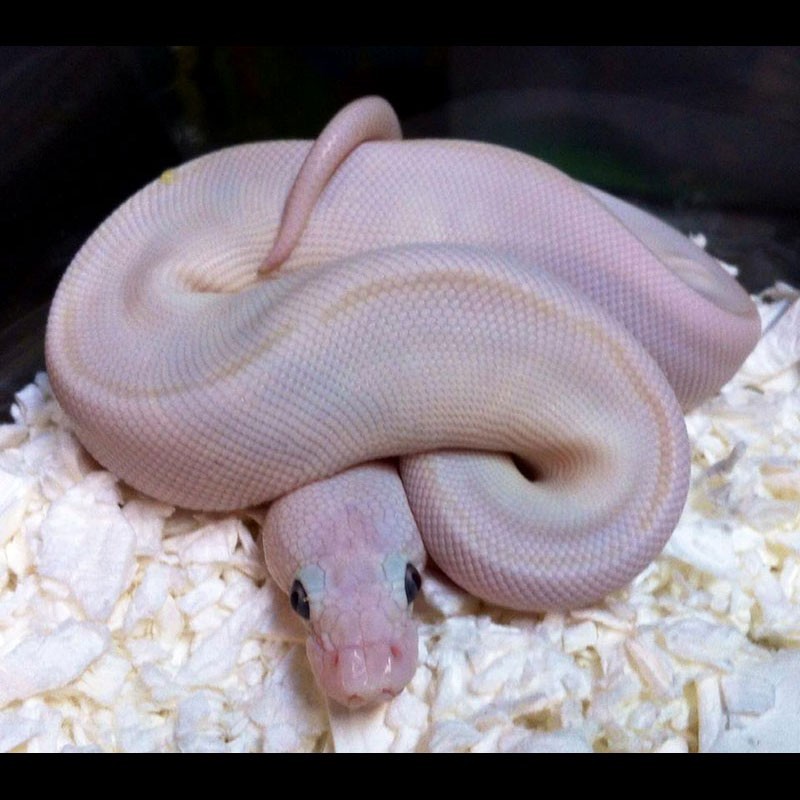 So, for a pair of Angolan pythons (Python anchieta), the smallest representatives of the genus, only 130 cm long, a terrarium measuring 100x60x70 cm is quite sufficient. For all pythons of this genus, several strong branches must be placed in the terrarium, not only because pythons love to crawl, but also in order to more fully use the volume of the terrarium, especially with significant sizes of animals. Lighting and heating sources in terrariums for ethyl snakes are equipped according to general principles. The temperature of the content of pythons is 28-32 C during the day and a little less at night.
So, for a pair of Angolan pythons (Python anchieta), the smallest representatives of the genus, only 130 cm long, a terrarium measuring 100x60x70 cm is quite sufficient. For all pythons of this genus, several strong branches must be placed in the terrarium, not only because pythons love to crawl, but also in order to more fully use the volume of the terrarium, especially with significant sizes of animals. Lighting and heating sources in terrariums for ethyl snakes are equipped according to general principles. The temperature of the content of pythons is 28-32 C during the day and a little less at night.
Humidity levels should be high when keeping these snakes, especially when keeping this python (Python regius). For this purpose, a terrarium is sprayed, moisture-retaining types of soil are used, and a large pool is built in. The latter is absolutely necessary, since all pythons spend a lot of time in the water, especially before molting. The water temperature should be about 25 C. They feed snakes with rodents and birds, large snakes can eat rabbits.
They feed snakes with rodents and birds, large snakes can eat rabbits.
Python feeding
Royal pythons are carnivores, in captivity young pythons eat small mice, adult snakes eat mice, rats, hamsters, chickens or quails. Food must be mortified and frozen. Before feeding, food is thawed. Avoid feeding live food, as it can cause serious injury to snakes, and rodents can also be infected with various diseases.
The feeding frequency of the python depends on its age, keeping temperature, prey size and snake activity. Young snakes eat 1-2 times a week, adults can eat once every 1-2 weeks. In winter, if the temperature is low, the snake eats even less or refuses to eat at all for several weeks. Pregnant females do not feed until they lay eggs. Moulting snakes don't eat at all. Royal pythons are prone to obesity. They feed pythons in the evening or at dusk.
If the python has not eaten for more than 1-4 months, carefully monitor its weight. If the king python has lost too much weight, you have to force-feed him, or try to put the snake in a small space and put a live mouse (not dairy, but already a little independent, which cannot harm the snake) in the same place. The mouse will run over the snake and annoy it. In most cases, reptiles eat the food offered. If the python refuses to eat further, check his mouth, he may have stomatitis.
The mouse will run over the snake and annoy it. In most cases, reptiles eat the food offered. If the python refuses to eat further, check his mouth, he may have stomatitis.
Breeding pythons
Pythons of the central genus mate in late autumn - early winter. 20-30 days before this, the snakes are seated and kept at lower temperatures (18-20 C) and shorter daylight hours singly. Most pythons in captivity incubate their clutches themselves, otherwise they can be successfully artificially incubated at 28-32 C and 100% humidity.
7-10 days after birth, young pythons molt and begin to feed on small mice. Pythons reach sexual maturity at different ages. Thus, it is known to receive offspring from a female dark tiger python (Python molurus bivittatus) at the age of only 18 months, although this is usually 3.5-4 years. Large pythons reach maturity later - the youngest female reticulated python, who brought offspring in captivity, was 5.5 years old, hieroglyphic - 6 years old.
In recent years, royal pythons have become very popular. More and more keepers prefer these calm and beautiful snakes of African origin. They are not whimsical in content and can even suffer small amateur mistakes.
Royal pythons are also called ball pythons or ball pythons. These snakes are not venomous.
Description of royal pythons
This type of python is one of the smallest. The body length of royal pythons ranges from 1.2 to 2 meters. The body of these snakes is powerful, thick, the tail is short.
A pattern of alternating irregular dark brown or light brown stripes and dark brown or black spots runs along the body. The belly has a cream or white color, sometimes small dark spots can be scattered over it.
Distribution and lifestyle of royal pythons
These snakes live in Central and West Africa: in Mali, Senegal, Guinea, Niger, Ghana, Sudan, Chad and the like. Royal pythons live in savannas and equatorial forests.
These snakes are nocturnal, during the day they sleep in shelters (hollows, burrows, leaf litter), and at night they begin to hunt. They are great swimmers and love to dive into the water. In addition, they can climb trees.
If the python is in danger, it rolls up into a strong ball, inside of which it hides its head, which is where the name “ball python” comes from.
The king python is one of the smallest snakes of its kind.
Royal python diet
In the wild, these snakes prey mainly on small mammals: rats, shrews, striped mice, and sometimes also eat birds.
Keeping royal pythons in a terrarium
These pythons are kept in horizontal terrariums. The optimal size is 100x60x60 centimeters.
During the day, the temperature in the terrarium is maintained in a warm corner up to 28 degrees, and in a cool corner - up to 25 degrees. At night, the temperature is lowered in a cool corner to 18 degrees, and in a warm corner to 20 degrees.
Royal pythons are nocturnal animals and do not require UV lamps. Illuminate and heat the terrarium with incandescent lamps or a heating cable.
Since the habitats of royal pythons are the African savannas, it is not recommended to make excessive humidity in the terrarium, it should be maintained at 50-60%, but during the molting period it is increased to 70-80% to make it easier for the snake to throw off the old skin.
It is imperative that you provide a snake shelter that is appropriate in size. There should also be a bowl of water in which the python will fit completely. Pythons will not drink standing water, so it should always be fresh.
Peculiarities of feeding royal pythons
Royal pythons are fed rats and mice. They can also be given captive-bred Mongolian gerbils. It is not recommended to feed hamsters to the python, as he may not take other food later.
The food must be selected according to size, as the snake can sometimes be frightened of large prey. Until the age of six months, royal pythons are fed once a week, growing individuals are fed once every 10 days, and adults - no more than once every 2-3 weeks. Excess food can cause snakes to become obese, which causes a decrease in the reproductive capacity of the snake and the deterioration of its condition.
Until the age of six months, royal pythons are fed once a week, growing individuals are fed once every 10 days, and adults - no more than once every 2-3 weeks. Excess food can cause snakes to become obese, which causes a decrease in the reproductive capacity of the snake and the deterioration of its condition.
After feeding, the pythons are not disturbed for 2-3 days. At this time, do not allow temperature changes in the terrarium, as this can cause regurgitation. In adult pythons, seasonal refusals of food occur, this is due to the breeding season.
Royal python moult
Before molting, royal pythons, like many other snakes, cloud their eyes, forming a kind of film on them. At this time, increase the humidity in the terrarium. You can add vitamins to food. Vitamins are added once a month. But it is worth considering that not all vitamins are useful for pythons, vitamins A, D, E, K cannot be used, for example, vitamin D removes calcium from the body of a python.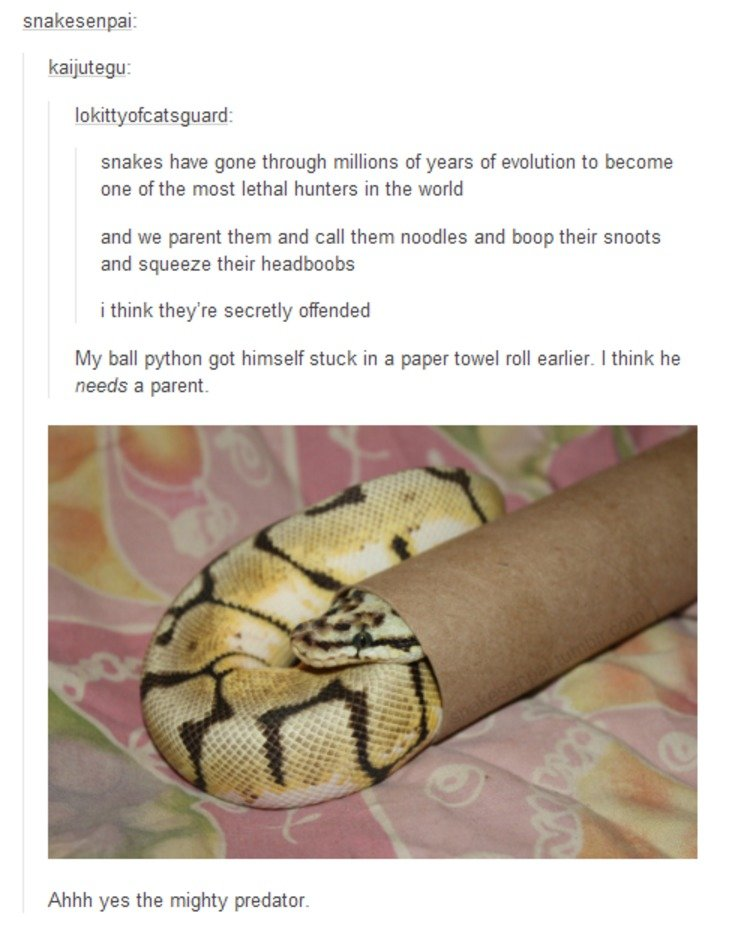
Reproduction of royal pythons
These snakes reach sexual maturity at a certain weight: the minimum weight of females is 1.5 kilograms, and that of males is 750 grams.
In the early stages of pregnancy, females actively eat, but in later stages they completely refuse it. They tend to stay in the warmer parts of the terrarium. The gestation period is 128 days.
Before laying eggs, the female starts looking for a suitable place. At this time, the female is carefully monitored so that she does not choose an unfortunate place and does not lay her eggs, for example, next to a heater. To do this, the terrarium should contain a container with wet moss, in which a large female can completely fit.
The temperature of the moss must not exceed 31 degrees. With a short-term decrease in temperature to 25 degrees, the embryos are able to survive, but with an increase to 32 degrees, they are guaranteed to die.
During the period of incubation, females do not roll into a ball if something threatens them, they actively attack and protect offspring. There should be a drinker near the female so that she can reach it without getting out of the egg container.
There should be a drinker near the female so that she can reach it without getting out of the egg container.
It is recommended that all keepers keep diaries that indicate the type of snake, its sex, time of acquisition and approximate age. In the same journal, the state of health, molting, masonry, and behavioral changes are noted.
If you find an error, please highlight the text and press Ctrl+Enter .
In this article I will tell you all about how to keep royal python at home, what kind of terrarium he needs, how to equip the terrarium so that the python is comfortable and how to feed the royal python.
Royal python is not a very large representative of its kind. With a fairly small size (males reach a length of one and a half meters, females almost two meters), this species has a very powerful body. The thickness of the body of an adult snake can be fifteen centimeters. With such a thickness, if the python shrinks, even an adult man will not have enough strength to unclench it.
Due to its small size, amazing coloration and variety of shapes, the royal python is becoming a popular pet for exotic lovers.
Before buying a snake, you should find out whether it was born in captivity or caught from nature. I recommend buying only those snakes that were born already in captivity and from an early age. There are several reasons for this:
- A snake that was born in captivity adapts much more easily to home conditions. While she is small, she endures a change of conditions relatively painlessly, which cannot be said about adult snakes. Snakes caught in nature very rarely get used to home conditions and in most cases die.
- Buying a snake that was born in captivity, you will definitely be able to find out its age, and knowing this data already, you will be able to understand whether the snake was kept normally or was underfed. There are cases when the snake, on the contrary, is overfed. This is very harmful if you want to breed royal python.
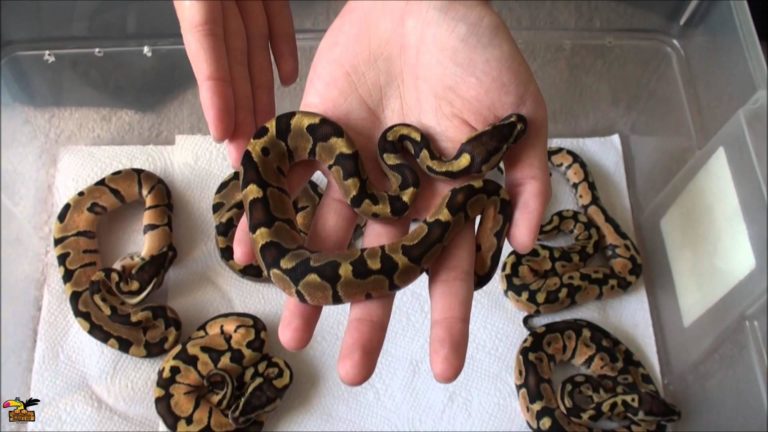 I was very lucky when I bought my python. I took him literally two weeks after he hatched and I personally follow his growth.
I was very lucky when I bought my python. I took him literally two weeks after he hatched and I personally follow his growth.
Keeping this snake at home is not very easy, you need to carefully monitor the conditions of keeping young snakes. After you buy a python, he may have stress for the first week and may refuse to eat. I had exactly that. Then I transplanted it into a small container, 40x40x40 centimeters, put an incandescent lamp on top and maintained a temperature of at least 27 degrees and a high humidity of 80 percent. Plus, there was a container of water inside so that the snake could bathe.
A week after these conditions, my python ate his first mouse and began to eat steadily. To keep an adult snake, you need a fairly large terrarium. The dimensions of my terrarium are 70x40x50. One corner of the terrarium must be heated to 32 degrees. As bedding, you can use either artificial bedding or coconut. I prefer to use coconut. It retains moisture much better and the aroma of pure coconut is pleasant.
Make sure to put some covers in the terrarium. These can be empty pots, snags (snags), a piece of bark, caves and much more where the snake can hide. In nature, royal pythons climb branches and can hunt from them. It will not be superfluous to put a large branch so that the snake hunts from a height. Also in the terrarium should be a cup of clean water. Pythons not only drink water, but also love to swim in it. As the snake grows, increase the volume of the cup.
Young king pythons should be fed twice a week to an adult mouse, provided that the temperature is maintained and the snake has time to digest the food. Adult pythons can be fed once a week or two weeks with a large rat. When snakes begin to feed on rats, they begin to grow much faster, this is due to the fact that they are more nutritious.
From my experience I can suggest the following feeding scheme:
- While your python is small, buy him one adult mouse once a week and keep the temperature around 27 degrees and humidity 80 percent.

- As soon as your snake grows up to 30 centimeters, you can try to offer it a small rat, slightly larger than an adult mouse. And so gradually increase the size of the food object.
- Adult rats should only be given when the python has reached its maximum size of one and a half or two meters and has a massive body, otherwise the rat may damage it. In my opinion, it is better to give several young rats in turn than to risk the animals.
- My king python is very good at eating chicken, plus they are cheaper than rats and can't hurt your animal. So if you can get chicks of the right size, feed them.
Do you like royal pythons? Do you already have such a pet or just want to get one?
53 comments:
Royal python. Features of keeping at home. Every year the number of those wishing to have exotic animals at home or in the office is increasing. It is already difficult to surprise us with dogs, cats, hamsters, talking parrots or just fish. People are drawn to the mysterious but attractive wild animals that you want to see not only in TV programs or behind bars in the zoo, but also in close proximity to yourself. So a person tries to tame wild cats, Tasmanian devils, wolves, spiders, wild birds, monitor lizards, iguanas, turtles and even snakes. Of course, preference in choosing reptiles falls on non-poisonous representatives, although amendments are possible here. And one of the most common reptiles in the terrarium is royal python, , the content of which at home will be discussed in our article.
People are drawn to the mysterious but attractive wild animals that you want to see not only in TV programs or behind bars in the zoo, but also in close proximity to yourself. So a person tries to tame wild cats, Tasmanian devils, wolves, spiders, wild birds, monitor lizards, iguanas, turtles and even snakes. Of course, preference in choosing reptiles falls on non-poisonous representatives, although amendments are possible here. And one of the most common reptiles in the terrarium is royal python, , the content of which at home will be discussed in our article.
Habitat
We all imagine the environment in which reptiles live. This is tropical forests with high humidity and sweltering heat, where, under the canopy of centuries-old trees, snakes and other unpleasant entities hide from the scorching sun. Speaking of the royal python, it can also be argued that its habitat, which runs mainly along the western coast of Africa, fully corresponds to the picture described earlier.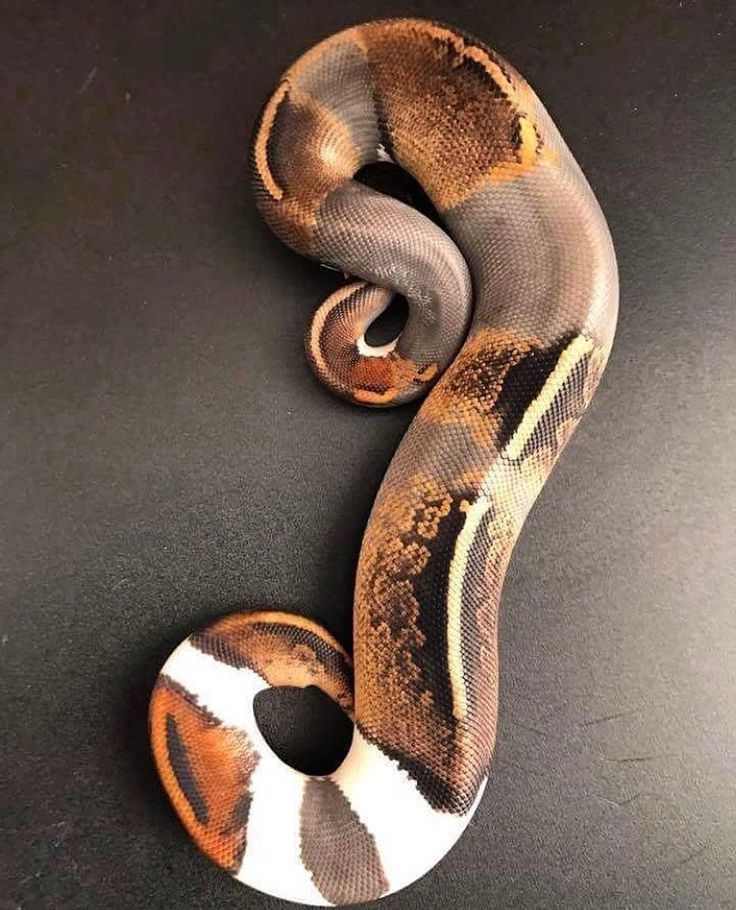
This snake can also be found in Central Africa, but it is much less common there, because snakes love moisture and water, and arid Africa rarely boasts of these conditions. Senegal, Mali, Côte d'Ivoire, Sierra Leone, Guinea, Nigeria, Cameroon and some other countries on the west coast have become a haven for the royal python. Usually pythons reach a somewhat large size compared to the royal ones. But, nevertheless, this reptile has an impressive size and a very well-developed muscular structure, which helps not only in moving and overcoming obstacles, but also during hunting. After all, it is no secret that pythons are not poisonous, and therefore, to obtain food, they use the impressive strength of the rings of their torso, where each segment is endowed with powerful muscle fibers. When contracting, these fibers squeeze the victim with such force that it is basically impossible to escape or escape.
Do you know? Like many other reptiles, the female is much larger than the male. So the length of the average female snake is about two meters, while the males do not exceed one meter. This is one of the few external signs by which the sex of a reptile can be determined.
So the length of the average female snake is about two meters, while the males do not exceed one meter. This is one of the few external signs by which the sex of a reptile can be determined.
The color of the royal python fully justifies its pretentious name. Plays of black and golden scales create a truly aristocratic coloring of these snakes. And, as if this was not enough for nature, a golden-yellow triangle flaunts on the head of the python, which is called its crown. With such an appearance, the royal python is one of the most memorable and, no matter how strange it may sound, pleasant to look at among the rest of the reptiles.
Morphs
The morphs of the king python are quite varied and each species has its own distinctive features. Let's take a look at the most popular morphs of the royal python. These include:
In general, there are a great many variations of the royal python, each of which stands out for its unique skin tone or unique eye color.
Every tamed living creature needs proper care and comfortable living in the same territory as the breeder. And royal pythons are no exception to this rule.
Construction of the terrarium
Due to the fact that pythons are terrestrial animals and they are extremely rarely drawn up, the terrarium should have larger dimensions in its width than in height. So this terrarium should be of the horizontal type with maximum room for the reptile to move around.
Important! The minimum size for an adult terrarium is 0.8 x 0.5 meters. In the event that it is possible to expand these dimensions, then this is definitely worth doing. Your pet will thank you. Keep in mind, though, that as you increase your snake's living space, you increase the difficulty of maintaining the necessary parameters inside it, such as humidity and temperature.
Not so long ago, glass was the main material for terrariums, but nowadays plastic products, which are distinguished by increased practicality and durability, are becoming especially popular. So, the plastic terrarium has rounded corners, so it will be much easier to clean it. In addition, tightness and strength, because glass can be broken even by accidentally hitting it, but plastic is quite difficult to damage. Therefore, when choosing a home for a reptile, you should give preference to a plastic terrarium with a sliding glass door.
So, the plastic terrarium has rounded corners, so it will be much easier to clean it. In addition, tightness and strength, because glass can be broken even by accidentally hitting it, but plastic is quite difficult to damage. Therefore, when choosing a home for a reptile, you should give preference to a plastic terrarium with a sliding glass door.
The bottom of the terrarium for royal pythons is lined with several fillings to choose from. Among them are:
- cypress shavings;
- torn newspapers or paper;
- artificial special substrate.
Important! Contrary to popular belief, it is better not to use sawdust, especially if it is from cedar wood. Such litter is highly toxic to snakes, and this will lead to adverse consequences.
Whatever filler you decide to use, the main rule is that there should always be a replacement material nearby so that your pet is comfortable.
In addition to the soft bottom, it is worth taking care of secluded places where the reptile can hide from prying eyes. For this, you can adapt a flower pot or a shoe box, if we consider budget options. But if your funds allow, you can equip the terrarium with special items that are sold in stores: driftwood, an empty tree trunk, rocky mounds and others. The main thing here is not to overdo it, because there should be a place for movement and hunting.
For this, you can adapt a flower pot or a shoe box, if we consider budget options. But if your funds allow, you can equip the terrarium with special items that are sold in stores: driftwood, an empty tree trunk, rocky mounds and others. The main thing here is not to overdo it, because there should be a place for movement and hunting.
Living plants in a terrarium look very ergonomic, but this option will not simplify your task at all, because you will have to look after not only the snake, but also the greenery.
Care and Hygiene
But if you think that the choice of flooring materials and decorations will complete the arrangement of the home for the royal python, then you are deeply mistaken, because you still have to take care of lighting, humidity and temperature control. So, for lighting a terrarium, broad-spectrum fluorescent lamps are usually used, which will most effectively spread light over the entire area of \u200b\u200bthe dwelling.
In addition, you should adjust the lighting time, because for royal pythons, 12 hours of daylight and 12 hours of night time is considered normal. But even here, not everything is so simple, because in winter this time should be changed to 10 hours of light and 14 hours of darkness, but in summer, on the contrary, the light period will be 14 hours and only 10 at night.
But even here, not everything is so simple, because in winter this time should be changed to 10 hours of light and 14 hours of darkness, but in summer, on the contrary, the light period will be 14 hours and only 10 at night.
The next step in arranging the terrarium will be heating. An ordinary incandescent lamp or a special rug that is placed under the terrarium can be responsible for this function. Here the main thing is to maintain a constant temperature of 25-27°C during the day and 20-22°C at night, so that the reptile feels the same as in natural conditions. If the terrarium already has a heating source, then it should not be placed near other heating devices, such as a battery or a convector, because overheating is possible, which can adversely affect your pet's health.
It's no secret that wooden terrariums retain heat better, and plastic and, moreover, glass ones are much worse. Also in this situation, the rule applies, the larger the terrarium, the more resources will be spent on heating and lighting.
Another essential ingredient for keeping your reptile comfortable in your home is humidity. It should be maintained with the help of an artificial reservoir inside the python's dwelling. Reptiles are very fond of water procedures, and an artificial reservoir is the best way to fulfill this need. The water temperature should be within 25 ° C, and its replacement should be done every day.
Feeding and Diet
The royal python's diet is dominated by meat, as these reptiles are known for their hunting skills and silent killing ability due to their powerful rings of long torso. As a result, you, as the owner of such a snake, will have to fulfill its whims and supply frozen carcasses of small animals as food for the python. Royal python's favorite treats include:
- rabbit;
- hamster;
- quail;
- chicken;
- rats;
- mice.
Thanks to this diet, your pet will feel great, and his body will receive all the necessary nutrients and trace elements that are used to maintain the normal functioning of all organs and systems of the animal.
Important! Pythons, due to their physiological characteristics, tend to be overweight and even obese. Therefore, you should carefully monitor the balance of their diet so as not to overfeed the reptile.
For active juveniles, the feeding frequency varies between two and three times a week. This volume will be enough for them to maintain high activity and proper functioning of the body. As for older reptiles, they should be fed no more than once a week. The process of digestion of food in snakes is quite long, and therefore their feeding has such features.
Another important point is the need to feed the royal python in the dark, because snakes hunt exclusively at night. In the life of a snake, there come such moments when it can simply refuse to take any food. This most often occurs in winter or during pregnancy. In these cases, females may not eat for up to four months until they lay their eggs.
Anyway, it is important to monitor the animal's weight during this period so that it does not drop to a critically low level. If this happens, then you need to offer the snake live prey. Often in such a situation they resort to the help of a small mouse. If this does not help and the snake will refuse to eat and lose weight, you need to check it for stomatitis at the serpentologist.
If this happens, then you need to offer the snake live prey. Often in such a situation they resort to the help of a small mouse. If this does not help and the snake will refuse to eat and lose weight, you need to check it for stomatitis at the serpentologist.
Breeding
If you decide to experiment and start breeding royal pythons right at home, then this is possible. This process can even be further stimulated by lowering the temperature in the terrarium to 21°C in autumn. The lower average daily temperature favorably affects the pythons and contributes to the start of mating games.
If everything goes well, then after four months there will be a dozen more baby serpents in your terrarium. After the female lays eggs, and there are from three to fifteen of them in one brood, a long (about 55 days) incubation period begins. This can also be done in a natural way, when the female heats the offspring with her body, or in incubation, when a constant high temperature is maintained in the incubator, about 35 ° C. One way or another, but at the end of the fourth month, the offspring of your royal python will appear.
One way or another, but at the end of the fourth month, the offspring of your royal python will appear.
Danger
For each person a snake is associated with some danger hidden in it. We are afraid of her bites, afraid to even touch her cold skin, not to mention holding her in our arms. And as a result of our stereotypes, the question arises: is the royal python dangerous for humans? We can unequivocally answer that our prejudices do not apply here, and the python is not dangerous to humans. On the contrary, he is peaceful and calm in his presence, and in terms of adaptation to life in captivity, royal pythons are among the first in the ranking of reptiles.
The only thing you should not do is spin the python around your neck, because its instincts are on the alert and can easily stop your breath. Also, do not let children near him, because his sudden movements or a sudden jump can scare them a lot, and the python is not the best toy for a child.
The bite of the royal python is also not dangerous, because these snakes are not poisonous. But the bite site is still desirable to sterilize and lubricate with iodine. Along with the royal pythons, tiger and reticulated pythons are most often domesticated. But if the first of them are far from aggressive, then problems may arise with the second. Due to the fact that reticulated pythons exceed the length of 10 meters, they can easily deal with their smaller relatives, despite their royal title. Therefore, you should not keep these two pythons together, because the crown can very easily go to another.
Personality and lifestyle
Although royal pythons are native to the wild, their temperament is quite calm and laminar, especially when compared to other members of the serpentine kingdom. There is even a certain friendliness in these creatures, but in matters of hunting they are still the same ruthless predators and killers. In the daytime, these reptiles, as a rule, find a secluded place for themselves where they can relax and soak up the sun. They curl up and get comfortable.
They curl up and get comfortable.
And here is with the onset of night, life begins for the royal pythons. Their energy, accumulated over the whole day, finds its outlet and contributes to the relentless movement of the predator. It is at night that you should feed the royal python, because in the daytime he most often sleeps. Unfortunately, this lifestyle does not give him any advantages as a pet, because during the day you can only watch how he peacefully curled up in the corner of the terrarium and rarely become witnesses of his movements.
Moulting
Before the start of this process, all reptiles have some blurred vision. This is due to a special outgrowth that approaches the animal's eyes like a veil. Literally a few days after the discovery of a translucent film on the eyes of a python, you will find peeling and peeling of the skin. It is not necessary to help the python in this matter, because nature has provided for everything itself. During this period, you need to increase the humidity in the terrarium. You can spray the python a couple of times a day with a spray bottle, but the water should be quite hot, about 27 ° C. At the end of the molt, the peeled skin must be removed.
During this period, you need to increase the humidity in the terrarium. You can spray the python a couple of times a day with a spray bottle, but the water should be quite hot, about 27 ° C. At the end of the molt, the peeled skin must be removed.
Health and Prevention
Before moving on to diseases that reptiles can be exposed to, let's find out how long a king python lives. The average life span of these snakes is 20-30 years. But in captivity, there are other cases that can surprise.
Do you know? Royal pythons are among the longest living snakes. So, their maximum life expectancy as a pet is 50 years.
The first sign of illness in a python is food refusal and weight loss. If there is a significant reduction in the weight indicator, then you need to force-feed the pet. If, in this case, he refuses, then most likely the reason for this is stomatitis, which is one of the most common diseases in snakes. With a careful examination of the mouth, you can independently detect this disease. You can also contact a serpentologist.
You can also contact a serpentologist.
Other possible diseases of the royal python can be:
- dystocia - a disease associated with a violation of the process of oviposition and accompanied by stopping the egg in the genital tract;
- emaciation of various origins and severity;
- prolapse of organs from the cloaca;
- disecdis;
- acute or chronic respiratory syndrome;
- cryptosporidiosis is a protozoal disease accompanied by significant depletion of the reptile.
If all the rules of care, hygiene and maintenance of the reptile are observed, the risk of exposure to any of the above diseases is significantly reduced. Therefore, it is important to monitor the condition of your pet and respond in time to the slightest manifestations of ailments.
As a preventive method, you can connect special vitamin complexes that will help maintain immunity and replenish the missing nutrients and trace elements necessary to maintain the health and proper functioning of the animal's body.
Choosing a pet has always been an important and responsible step, because after the animal leaves its previous home, it will become yours and will depend entirely on your decisions and actions. Before you opt for representatives of the snake kingdom, you need to take a closer look at them and feel whether it is worth associating yourself with them or your impulse is momentary and the snake, in fact, is not of interest to you.
After all, you must admit that it is still possible to adopt a kitten or a puppy if you suddenly have a previously hidden allergy, but finding a new owner for a python, even a royal one, is not so easy. In addition, you need to carefully prepare for the reception of a new inhabitant at home and equip comfortable conditions by properly equipping the terrarium and preparing food and bedding for the first time. And although it seems that the python does not require much attention, in fact, like any living creature, it will also need your care.











